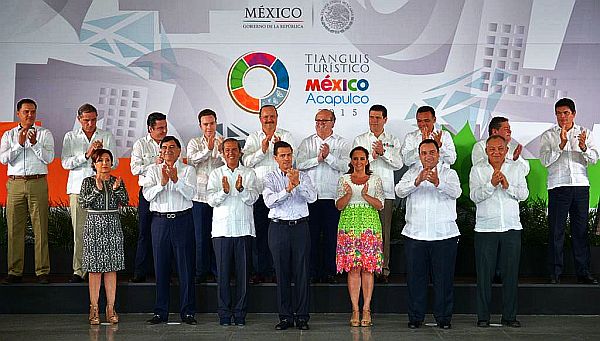Acapulco, Mexico - Tourism is one of the biggest revenue producers in Mexico, and is promoted by the government and private business.
Besides helping the economy, if tourism is managed properly, it can encourage local communities and residents to preserve the environment and take care of historical and cultural sites. If people have a vested economic interest in such attractions, they take care of them. After all, if you let things deteriorate you're losing money.
And Mexico has much to offer both domestic and foreign tourists.
 |
Pre-Hispanic archaeological sites abound. Visitors to the Yucatan peninsula can visit Chichen Itza, Coba and Tulum. Cholula has the world's biggest pyramid by volume. The Teotihuacan complex near Mexico City is quite impressive to visit. In Mexico City, tourists can spend time at the world-famous anthropology museum, where artifacts from various pre-Hispanic cultures are exhibited. Downtown one can see the Templo Mayor museum of the Aztec culture.
Spanish colonial architecture can be found in many Mexican cities. The Spaniards constructed beautiful cities such as Queretaro, Guanajuato and Zacatecas. The downtown areas of these cities are still well-preserved and look as they did centuries ago. There is impressive art and architecture to be found in colonial churches all over Mexico. And, it's interesting to point out that back in the 1985 Mexico City earthquake, colonial buildings fared better than many 20th-century constructions.
Mexico possesses a great variety of regional cultural attractions - traditional cuisine, costume and custom, including seasonal observances.
So there is plenty to see in Mexico.
The Anual Tianguis Turístico, an annual trade fair for Mexican tourism, is sponsored by the Mexican Secretaría de Turismo Federal y el Consejo de Promoción Turística. It's been held since 1975, making this year's Tianguis, held in Acapulco as the vast majority of them have been, the 40th anniversary of the fair.
(The word tianguis is an interesting term. It means "market" and derives from the Nahuatl tongue, spoken by the Aztecs and kindred peoples.)
 |
Quoting the World Tourism Organization, Peña Nieto announced that Mexico is among the ten most visited countries of the world.
In calendar year 2014, there were 29.1 million foreigners who visited Mexico, bringing 16 billion dollars into the Mexican economy. That was an increase over the 2013 figure of 24.2 million foreign tourists.
Will the ongoing drug cartel violence scare away tourists? It undoubtedly does scare away some potential visitors. Nevertheless, there are plenty of foreigners still willing to visit Mexico. As the figures quoted above show, that number is actually increasing.
This doesn't mean there is nothing to worry about. The tourism industry could potentially be damaged by the security situation, so the big tourist resorts are generally kept safe. The vast majority of foreign tourists enjoy their visits to Mexico. But there is that minority of tourists who have bad experiences. Sometimes it's the tourists' fault, sometimes not, but it happens.
Then there is that small minority of foreign tourists who practice what is called "revolutionary tourism." These so-called "revolutionary tourists" are people who like to go to places where fighting is going on. Needless to say, that doesn't apply to most tourists, who definitely don't seek out trouble. That's not what they're looking for in a vacation.
So this is where the security issue intersects with tourism. If foreign perception of Mexico becomes one of a violent and dangerous place for tourists, then foreign tourists and potential tourists will just choose not to visit Mexico and go elsewhere. If Mexico's tourism revenues drop greatly, that's bad for the economy, especially for the regions that depend on tourism.
My family and I have had some good times traveling in Mexico, and we hope to continue to travel in Mexico and see many things the country has to offer. Allan Wall is an American citizen who moved back to the U.S. after living and teaching English in Mexico for a decade and a half. Today, he continues to write articles about various aspects of Mexico and Mexican society. Some of these articles are about Mexico's political scene, history and culture, tourism, and Mexican emigration as viewed from south of the border, which you can read on his website at AllanWall.info.
Allan Wall is an American citizen who moved back to the U.S. after living and teaching English in Mexico for a decade and a half. Today, he continues to write articles about various aspects of Mexico and Mexican society. Some of these articles are about Mexico's political scene, history and culture, tourism, and Mexican emigration as viewed from south of the border, which you can read on his website at AllanWall.info.


